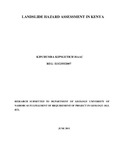| dc.description.abstract | Landslide problem has been little researched on in Kenya and there is lack of information on
rainfall threshold, nature of occurrence and characteristics which are vital information for GIS
data base creation for easy landslide monitoring. Landslide risk in Kenya is assessed in relation
to region geology, soil type, rainfall density and slope gradient. Areas identified as being most
risk are those affected by tectonic activities associated with the formation of Rift valley with
deeply weathered volcanic nitisol soil and high to moderate mean rainfall attracting large human
population settlement in these areas igniting landslides. Models of determination of physical
factors directly or indirectly correlated with slope instability and selecting rating system
according to hazard degree in an area need to be understood in which GIS can sustain
effectively. Establishment of sensors with wireless connection (Bluetooth) in these fields is
envisaged to monitor and warn on future occurrence. | en |

